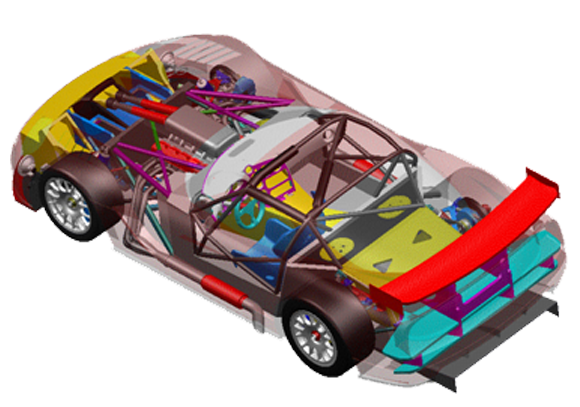Viper GTS-R Development
2002 Viper GTS-R

Viper GTS-R Introduction and History
In 2000 Chrysler recognized the Viper GTS-R was going to need a significant upgrade to remain competitive with the Pratt-Miller Corvettes at premier international endurance racing events, 24hr of LeMans, Daytona 24hr, 12 hr Sebring. RAETECH was commissioned to design the chassis and suspension for the new car scheduled to debut for the 2002 season. Class rule changes allowed the design to be much more aggressive the previous car with very minimal production volume requirements.
Though the program was terminated before a vehicle was built some of the design influences (body shape) appeared in the less ambitious Viper Competition Coupe.
Design Features
- Longer Wheelbase to improve Longitudinal Weight Transfer
- Upgraded Aerodydnamics
- Stiffer Chassis with no increase in Weight
- Improved Serviceability
Viper GTS-R Chassis
The 2002 Viper GTSR chassis was designed to have a 200% increase in torsional stiffness with a decrease in weight from 475 lbs. to 400 lbs. over the existing car. Another primary objective was to accommodate a 95th percentile male driver in the most ergonomically correct position possible. Racing, especially endurance racing, demands that the driver’s environment be easy to use with all major controls in easy reach. The new Viper chassis has been thoroughly studied for ergonomics and optimized for weight to stiffness ratio.

Viper GTS-R Front Suspension
The suspension design of the new Viper GTS-R was primarily driven by experience, from the current GTS-R campaigns, and the regulations of the ACO for the GT2 class. The car, like its predecessor, was to have a short-long a-arm suspension (SLA) in the front and back. It is well accepted that this type of suspension offers the best performance and flexibility for this application. Unlike the original GTS-R, which used many road-car production parts, this car was to have all custom parts designed for optimum racing performance. The car was to be sprung via a conventional outboard spring/shock assembly. Roll resistance was to be given by either a steel or carbon bar with a rotating blade for stiffness adjustments. Roll center height, roll center migration, improved motion ratios, and "anti-" geometry were all points of high concern in this effort. Compromises in the geometry were greatly reduced because the design was not constrained to the use “off the shelf" parts. All major suspension parameters were tunable and adjustments designed to be easily and accurately performed by the crew. The suspension of the new GTS-R was to be a refined racing design while retaining the simplicity and toughness that gave its predecessor so much success.

Certain key points, or design goals, were established at the onset of the project.
- Reduce center of gravity height
- Reduce system weight
- Improve motion ratio (>.7)
- Minimize suspension compliance
- Design components to be serviceable during races
- Design tuning and adjustments to be easily and accurately performed
- Minimize suspension friction
- Efficient load paths into chassis
- Simple and durable
- High build quality and repeatability
Each of these points were considered during the entire suspension design process. It is felt that the current design meets or exceeds all of these goals.
Viper GTS-R Rear Suspension
The rear suspension of the 2002 Viper GTS-R utilizes a double wishbone suspension. Traction was to be supplied by a Michelin 31/71-18 tire mounted on an 18"x13" BBS alloy wheel. A 4-piston Brembo caliper clinching a 14" carbon rotor performs braking. The aluminum upright was designed to be manufactured by CNC machining or an investment casting process. It is symmetrical, allows for a wide range of suspension parameter adjustments, and houses the carry- over hub. The control arms are all fabricated high-strength alloy steel pieces. The spring/shock assembly is similar to the one on the current GTS-R. Spring/Shock and cornering loads are fed directly into the 'C' bulkhead. Traction, braking, and anti-roll bar loads are all directed into the rearmost 'D' bulkhead. The anti-roll bar is a conventional alloy steel 1.625" diameter bar using rotating blades for stiffness adjustments.

Viper GTS-R Cockpit
Racing, especially endurance racing, demands that the driver’s environment be easy to use with all major controls in easy reach. The new Viper chassis has been thoroughly studied for ergonomics and every effort made to place the driver in a suitable position. The design goal of accommodating a 95th percentile male was achieved.
To confirm the computer model, a mock up cockpit was initiated to verify seat, foot pedal and steering wheel relationships. This effort grew to include the dash, factory steering column, roof, roll cage, shifter and tunnel.


